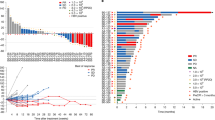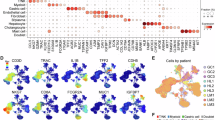Abstract
Metastasis to the liver remains an important problem in the treatment of patients with gastrointestinal cancer. We examined the mechanism and effect on liver metastasis of in vivo interleukin-2 (IL-2) gene transfer to the liver. RCN-9 cells derived from F344 rat colon adenocarcinoma were injected into syngeneic rats via the ileocecal vein to induce liver tumors. A total of 2.5×109 pfu of adenovirus vector harboring the human IL-2 gene (AdCMVhIL-2), or 2.5×109 pfu of control vector encoding β-galactosidase was administered before RCN-9 cell challenge. On day 14, mean tumor weight was 4.0±2.4 g in the control group, whereas IL-2–transduced livers had no tumors. Survival of AdCMVhIL-2–treated rats was significantly longer than that of control rats (P<.01). Flow cytometry demonstrated that the proportion of natural killer (NK) cells had increased among sinusoidal cells collected from IL-2–transduced livers. These cells were highly cytotoxic to RCN-9 cells in vitro in the presence of a physiological high concentration of recombinant IL-2. Preventative effects of IL-2 transduction of the liver against liver metastasis were lost after depletion of NK cells by treatment with anti–asialo GM1 antibodies. Our results indicate that IL-2 gene transfer to the liver prevents liver metastasis by continuously providing physiological high concentrations of IL-2 in the liver, thereby activating sinusoidal NK cells.
This is a preview of subscription content, access via your institution
Access options
Subscribe to this journal
Receive 12 print issues and online access
$259.00 per year
only $21.58 per issue
Buy this article
- Purchase on SpringerLink
- Instant access to full article PDF
Prices may be subject to local taxes which are calculated during checkout






Similar content being viewed by others
References
Gayowski TJ, Iwatuki S, Madariaga JR et al. Experience in hepatic resection for metastatic colorectal cancer: analysis of clinical and pathologic risk factors Surgery 1994 116: 703–711
Yoon SS, Tanabe KK . Surgical treatment and other regional treatments for colorectal cancer liver metastases Oncologist 1999 4: 197–208
Komatsu T, Yamauchi K, Furukawa T et al. Transcatheter arterial injection of autologous lymphokine-activated killer (LAK) cells into patients with liver cancers J Clin Immunol 1990 10: 167–174
Taniguchi T, Minami Y . The IL-2/IL-2 receptor system: a current overview Cell 1993 73: 5–8
Vujanovic NL, Yasumura S, Hirabayashi H et al. Antitumor activities of subsets of human IL-2–activated natural killer cells in solid tissues J Immunol 1995 154: 281–289
Rosenberg SA, Lotze MT, Yang JC et al. Prospective randomized trial of high-dose interleukin-2 alone or in conjunction with lymphokine-activated killer cells for the treatment of patients with advanced cancer J Natl Cancer Inst 1993 85: 622–632
Rook AH, Masur H, Lane HC et al. Interleukin-2 enhances the depressed natural killer and cytomegalovirus-specific cytotoxic activities of lymphocytes from patients with the acquired immune deficiency syndrome J Clin Invest 1983 72: 398–403
West WH, Tauer KW, Yannelli JR et al. Constant-infusion recombinant interleukin-2 in adoptive immunotherapy of advanced cancer N Engl J Med 1987 316: 898–905
Weichselbaum RR, Kufe D . Gene therapy of cancer Lancet 1997 349: SII10–SII12
Hogge GS, Burkholder JK, Culp J et al. Development of human granulocyte–macrophage colony-stimulating factor–transfected tumor cell vaccines for the treatment of spontaneous canine cancer Hum Gene Ther 1998 9: 1851–1861
Yoshida H, Enomoto H, Tagawa M et al. Impaired tumorigenicity and decreased liver metastasis of murine neuroblastoma cells engineered to secrete interleukin-2 or granulocyte macrophage colony-stimulating factor Cancer Gene Ther 1998 5: 67–73
Kim JH, Gong SJ, Yoo NC et al. Effects of interleukin-2 transduction on the human hepatoma cell lines using retroviral vector Oncol Rep 1999 6: 49–54
Maric M, Zheng P, Sarma S et al. Maturation of cytotoxic Tlymphocytes against a B7-transfected nonmetastatic tumor: a critical role for costimulation by B7 on both tumor and host antigen-presenting cells Cancer Res 1998 58: 3376–3384
Schreiber S, Kampgen E, Wagner E et al. Immunotherapy of metastatic malignant melanoma by a vaccine consisting of autologous interleukin 2-transfected cancer cells: outcome of a phase I study Hum Gene Ther 1999 10: 983–993
Slos P, De Meyer M, Leroy P et al. Immunotherapy of established tumors in mice by intratumoral injection of an adenovirus vector harboring the human IL-2 cDNA: induction of CD8(+) T-cell immunity and NK activity Cancer Gene Ther 2001 8: 321–332
Stewart AK, Lassam NJ, Quirt IC et al. Adenovector-mediated gene delivery of interleukin-2 in metastatic breast cancer and melanoma: results of a phase 1 clinical trial Gene Ther 1999 6: 350–363
Benedetti S, Dimeco F, Pollo B et al. Limited efficacy of the HSV-TK/GCV system for gene therapy of malignant gliomas and perspectives for the combined transduction of the interleukin-4 gene Hum Gene Ther 1997 8: 1345–1353
Drazan KE, Shen XD, Csete ME et al. In vivo adenoviral-mediated human p53 tumor suppressor gene transfer and expression in rat liver after resection Surgery 1994 116: 197–204
Inoue Y, Kashima Y, Aizawa K et al. A new rat colon cancer cell line metastasizes spontaneously: biologic characteristics and chemotherapeutic response Jpn J Cancer Res 1991 82: 90–97
Cantwell MJ, Sharma S, Friedmann T et al. Adenovirus vector infection of chronic lymphocytic leukemia B cells Blood 1996 88: 4676–4683
Graham FL, van der Eb AJ . A new technique for the assay of infectivity of human adenovirus 5 DNA Virology 1973 52: 456–467
Graham FL, Prevec L . Manipulation of Adenovirus Vectors New Jersey: Humana Press 1991 109–128
Thule PM, Liu JM . Regulated hepatic insulin gene therapy of STZ-diabetic rats Gene Ther 2000 7: 1744–1752
Bouwens L, Remels L, Baekeland M et al. Large granular lymphocytes or “pit cells” from rat liver: isolation, ultrastructural characterization and natural killer activity Eur J Immunol 1987 17: 37–42
Kasai M, Iwamori M, Nagai Y et al. A glycolipid on the surface of mouse natural killer cells Eur J Immunol 1980 10: 175–180
Ishizuka S, Kasai T . Suppression of the number of aberrant crypt foci of rat colorectum by ingestion of sugar beet fiber regardless of administration of anti–asialo GM1 Cancer Lett 1997 121: 39–43
Yoshioka H, Hama S, Sadatomo T et al. Transformation of rat glioma cells with the M-CSF gene inhibits tumorigenesis in vivo J Neuro-Oncol 1998 40: 197–204
Chomczynski P, Sacchi N . Single-step method of RNA isolation by acid guanidinium thiocyanate–phenol–chloroform extraction Anal Biochem 1987 162: 156–159
Nagashima S, Reichert TE, Kashii Y et al. In vitro and in vivo characteristics of human squamous cell carcinoma of the head and neck cells engineered to secrete interleukin-2 Cancer Gene Ther 1997 4: 366–376
Chen SJ, Wilson JM, Muller DW . Adenovirus-mediated gene transfer of soluble vascular cell adhesion molecule to porcine interposition vein grafts Circulation 1994 89: 1922–1928
de Roos WK, Fallaux FJ, Marinelli AW et al. Isolated-organ perfusion for local gene delivery: efficient adenovirus-mediated gene transfer into the liver Gene Ther 1997 4: 55–62
Brenner M . Gene transfer by adenovectors Blood 1999 94: 3965–3967
Shinozaki K, Yahata H, Tanji H et al. Allograft transduction of IL-10 prolongs survival following orthotopic liver transplantation Gene Ther 1999 6: 816–822
Toloza EM, Hunt K, Swisher S et al. In vivo cancer gene therapy with a recombinant interleukin-2 adenovirus vector Cancer Gene Ther 1996 3: 11–17
Bouwens L, Jacobs R, Remels L et al. Natural cytotoxicity of rat hepatic natural killer cells and macrophages against a syngeneic colon adenocarcinoma Cancer Immunol Immunother 1988 27: 137–141
Geerts A, Bouwens L, Wisse E . Ultrastructure and function of hepatic fat-storing and pit cells J Electron Microsc Technol 1990 14: 247–256
Divino CM, Chen SH, Yang W et al. Anti–tumor immunity induced by interleukin-12 gene therapy in a metastatic model of breast cancer is mediated by natural killer cells Breast Cancer Res Treat 2000 60: 129–134
Pham-Nguyen KB, Yang W, Saxena R et al. Role of NK and T cells in IL-12–induced anti–tumor response against hepatic colon carcinoma Int J Cancer 1999 81: 813–819
Lukomska B, Olszewski WL, Ziolkowska A et al. Immunological characteristics of cells entering the liver with portal blood Scand J Gastroenterol 1984 19: 1069–1074
Yu TK, Caudell EG, Smid C et al. IL-2 activation of NK cells: involvement of MKK1/2/ERK but not p38 kinase pathway J Immunol 2000 164: 6244–6251
Umehara H, Takashima A, Minami Y et al. Signal transduction via phosphorylated adhesion molecule, LFA-1 beta (CD18), is increased by culture of natural killer cells with IL-2 in the generation of lymphokine-activated killer cells Int Immunol 1993 5: 19–27
Nissen MH, Jeppesen M, Claesson MH . Splenocytes cultured in low concentrations of IL-2 generate NK cell specificities toward syngeneic and allogenic targets Cell Immunol 2000 203: 47–54
Okimoto T, Yahata H, Fukuda Y et al. Donor-specific suppressor T cells in a renal transplant recipient with a well-functioning kidney Transplant Proc 1994 26: 858–860
Takeshita T, Asao H, Ohtani K et al. Cloning of the gamma chain of the human IL-2 receptor Science 1992 257: 379–382
Acknowledgements
We thank Atsushi Miyanohara, University of California, San Diego, Program in Human Gene Therapy, for preparation of adenovirus vectors. We are also grateful to Yuko Ishida and Yasuko Kimura for excellent technical assistance. This work was supported, in part, by Grants-in-Aid from the Ministry of Education, Science and Culture, Japan, and by a grant from the Tsuchiya Foundation.
Author information
Authors and Affiliations
Corresponding author
Rights and permissions
About this article
Cite this article
Tanji, H., Yahata, H., Hayamizu, K. et al. Augmentation of local antitumor immunity in liver by interleukin-2 gene transfer via portal vein. Cancer Gene Ther 9, 655–664 (2002). https://doi.org/10.1038/sj.cgt.7700483
Received:
Published:
Issue date:
DOI: https://doi.org/10.1038/sj.cgt.7700483



